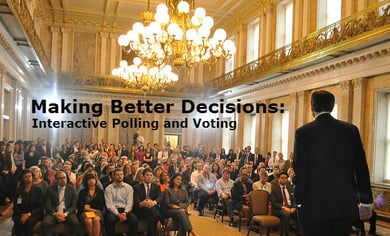
When an organization, a group within an organization, or any other gathering of people comes together for important decision-making tasks, group consensus is often a difficult and elusive outcome. Meeting facilitators must make sure the group members not only have the required information, but also share their perspectives and collaborate on the issues involved in order to make the best decisions. The use of wireless keypads and audience response technology makes this decision process easier and more effective.
Anyone that's used an electronic voting system using audience response technology will attest to the amazing speed and accuracy of the data it is able to tabulate and analyze. Many of these systems utilize Microsoft PowerPoint in order to create interactive PowerPoint polling slides with questions that attendees can vote on.
Some polling and voting software systems are even able to make use of a feature which allows anyone with a hand held browser-equipped device to participate without the need for interactive keypads. The system only requires you to use the browser on your device to navigate to a predesignated web address. This allows you to use your own smartphone, tablet, or notebook to participate from almost any location. In addition, the system automatically assigns an ID number to each connected device so that their responses are tracked and can be recorded separately from other connected devices.
As with a standard electronic voting system, the web-based polling tool instantly tabulates responses, assesses participant comprehension, monitors participation, measures perceptions, gathers feedback, and helps to stimulate discussion.
A great example of this technology in action comes from president and CEO of Option Technologies Mark Fite who stated “A good example of where it is especially useful would be a team of leaders for an organization in which there's some internal friction and a lack of collaboration between two key teams and constituents.” This statement refers to a situation that one of the largest celery growing companies in the world called upon the services of Option Technologies in order to resolve.
The company includes traders who sell the celery on exchange markets and farm managers who harvest the celery and get it to market. The groups are not physically contiguous and, as a result, they have difficulty developing personal relationships. This can result in fundamental misunderstandings of how to best address challenges and implement plans.
The challenge was to get the groups to collaborate to bring the highest-quality celery available to market at the specific time when demand was highest. By sharing information and working together to optimize harvest timing, the company could maximize returns from the sale of the celery.
"The timing of the harvest is everything," said Fite. "Depending on the market conditions and fluctuations in agriculture, celery can be worth more or less. So the whole goal with the commodity traders and the farm managers was to communicate clearly, anticipate trends in the market, and to harvest the celery at exactly the right time."
The company brought the two groups together — about 160 people — over a period of three days. Using OptionPower's Decision Support Module and wireless OptionFinder keypads issued by each participant, the group created and evaluated a list of statements. The module's list processing feature allowed participants to rank or agree/disagree with the statements to find areas of agreement and divergence.
"The questions were specifically designed to tease out the important differences of opinion between the two groups and the areas of friction so that we could begin to key up discussions to facilitate collaboration and understanding between the groups," said Fite.
According to Fite, participants started out very polarized. By the end of the three-day meeting, they were completely aligned around a new business process to optimize harvest timing based on market conditions.
Several hardware and software solutions for electronic voting are available for rent or purchase. ARS systems for electronic voting can scale from 10 people to as many as 15,000 participants in a single venue. You can learn more by clicking the button below.


